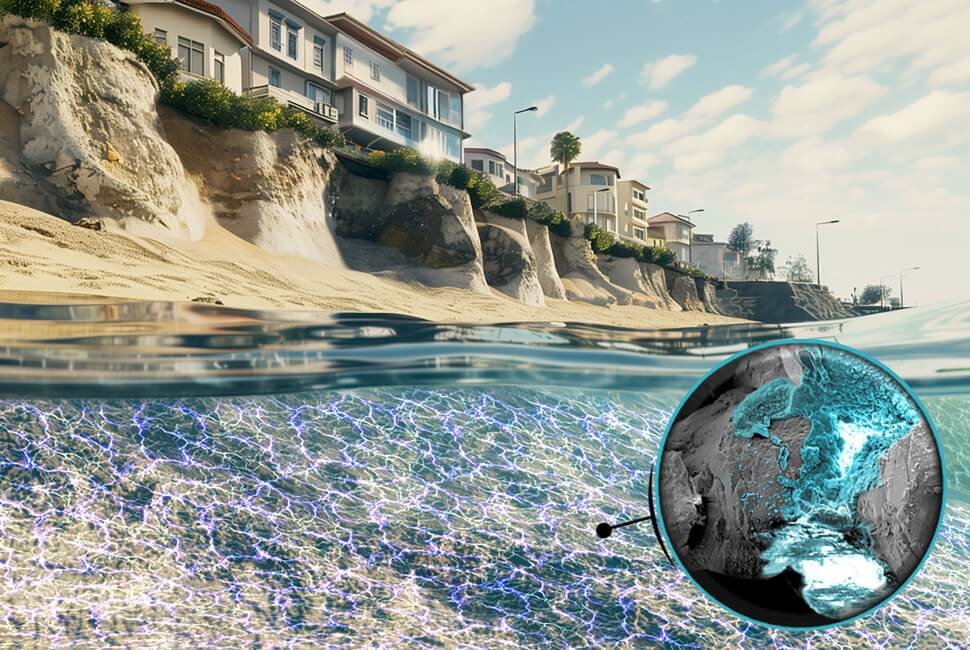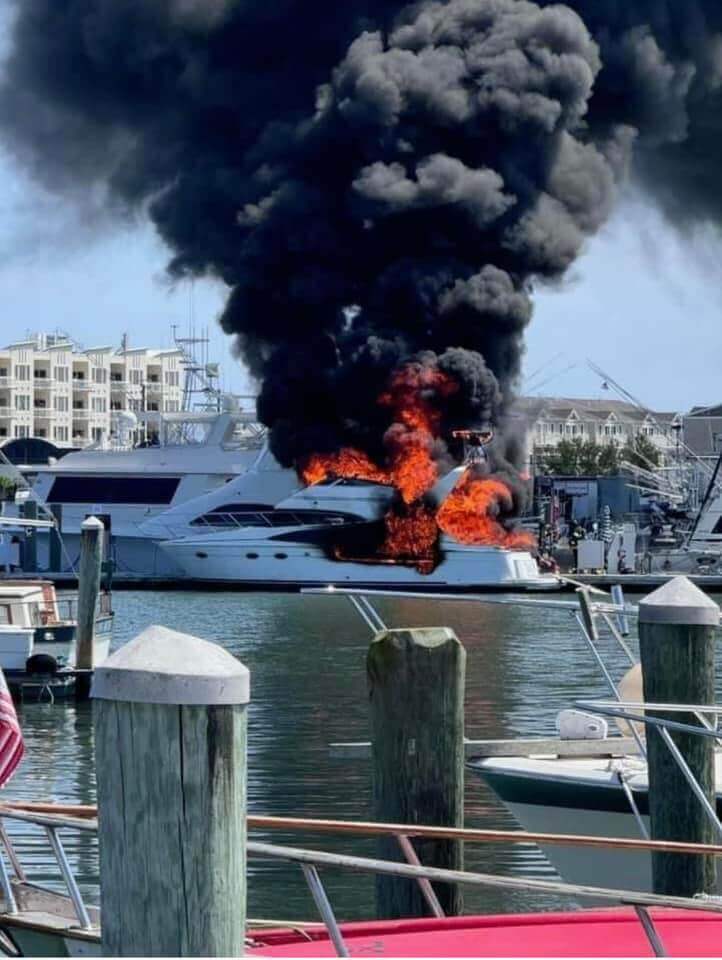Get “The Wrap,” our take on the news of the week, in your inbox every Tuesday. Sign up at: https://capemaycountyherald.com/newsletter-subscription/
Aug. 19-25
Zap the Sand, Save the Coastline

New research is suggesting that using an electric current to zap coastline sand may make it like an immovable solid less subject to erosion. It is a promising development that some researchers hope will make shorelines more resilient and less vulnerable to erosion.
Researchers from Northwestern University published research on this novel approach to protecting coastlines from the increased risk of severe erosion associated with climate change. Alessandro Rotta Loria, a civil and environmental engineering professor at the McCormick School of Engineering who led the research team, noted that “over 40% of the world’s population lives in coastal areas.”
The team mimicked processes used by clams and mussels, which naturally use dissolved materials in seawater to construct their shells. Researchers did not rely on the metabolic processes, using electric energy instead. The process produces bonding agents that transform the loose sand into a rock-like substance.
Picture a wall of sand created by erosion, then made solid like a natural seawall. The method promises to be cheaper, more resilient and, the research team says, reversible. It is eco-friendly, Rotta Loria says, because the voltages used in the process are too mild to interfere with sea life.
According to a study by the European Commission’s Joint Research Center, nearly half of the globe’s beaches will be washed away by the end of the century. The Northwestern researchers predict that this natural approach to protection should remain durable for decades.
The study is published in the journal Nature Communications Earth & Environment.
Energy Transition Finds Its Own Paths

We have known for some time now that the energy transition is chaotic at best. It has so many moving pieces, so many bureaucratic actors and so little real planning that things moving in odd directions given official goals is par for the course.
Now we find out that the push of the electrification strategy may be the biggest obstacle to closing coal generation plants. While states like New Jersey have ambitious goals for electrification of the automobile and small truck sector as well as home heating and cooling technologies, the rising demand for electricity is far outpacing the ability of power generators to produce the energy needed. Add to these demands for electricity the capacity required to satisfy the growing number of large data centers and the burgeoning use of artificial intelligence, both major consumers of electric power.
As of 2023 the U.S. plan was to take offline 133,000 megawatts of coal generation by 2035. Now that expectation has been significantly reduced. Aging fossil fuel plants are being used to accommodate surging demand.
Meanwhile, a series of reports from the Department of Energy is touting the strong showing of the wind energy sector, both land- and sea-based. The reports argue that wind power produced 12% of electrical capacity in 2023. But when the reports talk about the impact of offshore wind they use phrases about its being “set up to scale” or the amount of electrical capacity “in the pipeline.” The point is that offshore wind, whatever its ultimate promise, is not ready, certainly in New Jersey, to hit the ambitious early goals set by the state.
Lastly, Ford Motor Co. has scrapped plans for its totally electric SUV and overhauled its electric vehicle strategy. Ford sees electric vehicle technology in its future but now more as part of a hybrid strategy. It is a pivot that could cost the car maker as much as $1.9 billion, meaning the perceived need to move to a greater dependence on hybrids is not a decision taken lightly.
What does it all mean? Probably this energy transformation that was initiated with such fanfare and ambition is going to follow its own path depending on circumstances, markets, players and public opinion. The one thing you can probably count on is higher rates for electricity.
Drug Prices

The Inflation Reduction Act included provisions that allowed the Department of Health and Human Services to negotiate the prices for certain prescription drugs. Criteria were established for the drugs that could be negotiated. Ten selected drugs entered into these first negotiations. They were among the 50 products with the highest level of Medicare Part D spending. The negotiations set a maximum fair price for each of the 10 drugs, that price to take effect in 2026.
The drugs selected account for nearly $50.5 billion in gross Part D drug spending and were used by 9.7 million Medicare beneficiaries. The Centers for Medicare and Medicaid Services report that the new prices will mean a reduction of $6 billion based on 2023 volumes of prescriptions. According to Centers, people with Medicare prescription drug coverage are expected to see aggregated estimated savings of $1.5 billion in their personal out-of-pocket costs for these drugs in 2026. A list of the drugs and the newly negotiated prices is available at https://bit.ly/3X8M5KO.
Two examples of widely used drugs from the list show the impact of the negotiations. Eliquis, often used with blood-clot indicators, is used by 3.9 million users and will see a maximum fair price reduction of 54%. Jardiance, used for treatment of diabetes, will see a reduction of 64%.
A Brookings Institution study calculated the expected savings and predicted that similar savings can be expected from future rounds of negotiations as the program expands.
Happenings
Law enforcement responded to hoax calls in Avalon on Aug. 17 and 18, involving a bomb threat and a false murder report. Both incidents were determined to be “swatting,” and investigations are ongoing.
Avalon Business Administrator Scott Wahl defended the relocation of the Seventh Street outfall pipe, addressing residents’ concerns about transparency and the impact on the area. Despite his detailed explanation, some residents remain opposed to the project.
A dachshund-beagle mix was euthanized after being attacked by a German shepherd at a North Wildwood condo on Aug. 3. The shepherd’s owner compensated the smaller dog’s owner, but no police action was taken due to the incident occurring on private property.
The Cape May County Library unveiled a five-year plan to upgrade its services and main branch, focusing on community engagement and building a new brand. The plan aims to enhance user experiences and better connect with the community by 2028.
Roy Gillian, former Ocean City mayor and founder of Gillian’s Wonderland Pier, passed away at 94 on Aug. 17. He was deeply involved in local government and the amusement park industry, leaving behind a significant legacy in Ocean City.
The cannabis shop on Route 9 in Middle Township aims to open in September. The township will evaluate the shop’s performance before considering new cannabis business applications.
The Middle Thorofore Bridge in Lower Township reopened to all traffic on Aug. 21 after a rapid repair of its drive shaft motor. The bridge was closed for three days due to the motor failure but has returned to full operation.
Clermont resident Steven T. Seeburg, 63, was arrested on Aug. 20 for possession and distribution of child pornography after a search of his home revealed incriminating evidence. He faces serious charges and potential prison time.
Woodbine resident Peter Bosak transitioned from building an aviary to creating a vast botanical garden after snake invasions ruined his initial plans. With a background in entomology, he’s now planning to move to Florida to expand his tropical plant collection.
Cape May City Council introduced an ordinance on Aug. 20 to offer paid parking in the municipal lot adjacent to City Hall on weekends from April 1 to Dec. 31. Parking will be available Friday evenings and all day Saturday and Sunday, with a three-hour limit and a rate of 25 cents per 10 minutes.
North Wildwood City Council approved a resolution to switch dispatch services to Cape May County’s central 911 system starting Feb. 1, 2025, at an estimated $380,000 annually. Despite opposition from locals and union members, the decision was backed by police administration to improve service efficiency.
A 7-acre site in Lower Township, cleared for a 20-home development, has raised concerns due to its proximity to the Cox Hall Creek Wildlife Management Area. Officials confirmed that the site is privately owned and not part of the state’s wildlife area.
In July 2024, Stone Harbor issued 1,224 parking tickets, close to last year’s 1,247, yet there was little public outcry. The shift to ParkMobile from meters and kiosks has led to a significant rise in citations since 2023, with ongoing challenges in improving the situation.
Middle Township Committee has introduced an ordinance to increase annual sewer rates for single-family homes from $640 to $800 by 2027, with gradual increases over the next three years. The hike is intended to cover rising costs, increased sewage flow, and infrastructure needs.
Anthony Friel, 49, from Villas, was arrested in Atlantic City on Aug. 21 after fleeing police, driving down the boardwalk, and later attempting to escape on foot. He faces charges including eluding, drug possession, and resisting arrest.
John Lebeau is sailing his 22-foot boat, Vent d’Ete, from Florida to Stone Harbor after a 30-year separation. The vessel, partially restored and now seaworthy, is undergoing a journey that reconnects Lebeau with his past adventures and fulfills a lifelong dream.
The Nov. 5 ballot in Cape May County features high-profile races including presidential and Senate contests, alongside local elections in multiple municipalities.
A 42-foot boat named “Luv-It” caught fire and sank at Schooner Island Marina on Aug. 22, damaging the dock and a shed. The fire was quickly controlled, with no injuries reported; the cause is under investigation.

Spout Off of the Week
Cape May Beach – Beach Loudspeakers Mar the landscape of the beautiful natural sand beach & dunes. They are not helpful in storms even though it was supposedly the main reason they were installed. The lifeguards alerted beachgoers to leave the beach in recent storms. They left. There were no announcements. Also available could be auto phone alerts as is present in majority of seaside communities. The speakers/poles may even be a serious projectile hazard in high winds if snapped as incoming storms pop up. This was a project of good intentions but not a good result. It’s okay to remove them!
Read more spouts at spoutoff.capemaycountyherald.com.








